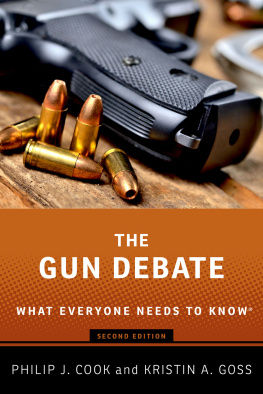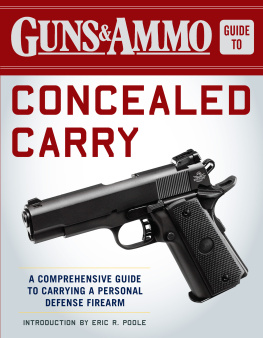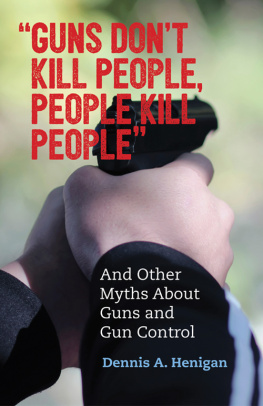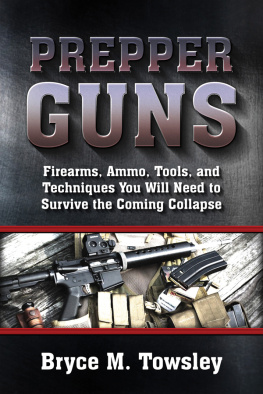First published 1997 by Transaction Publishers
Published 2017 by Routledge
2 Park Square, Milton Park, Abingdon, Oxon OX14 4RN
711 Third Avenue, New York, NY 10017, USA
Routledge is an imprint of the Taylor & Francis Group, an informa business
Copyright 1997 by Taylor & Francis.
All rights reserved. No part of this book may be reprinted or reproduced or utilised in any form or by any electronic, mechanical, or other means, now known or hereafter invented, including photocopying and recording, or in any information storage or retrieval system, without permission in writing from the publishers.
Notice:
Product or corporate names may be trademarks or registered trademarks, and are used only for identification and explanation without intent to infringe.
Library of Congress Catalog Number: 97-35884
Library of Congress Cataloging-in-Publication Data
Kleck, Gary, 1951-
Targeting guns : firearms and their control / Gary Kleck.
p.cm.(Social institutions and social change)
Includes bibliographical references (p. ) and index.
ISBN 0-202-30569-4 (pbk. : alk. paper)
1. Gun controlUnited States. I. Title. II. Series.
HV7436.K54 1997
363.330973dc21
97-35884
CIP
ISBN 13: 978-0-202-30569-1 (pbk)
To my wife Diane and my children Matthew and Tessa To my parents, William and Joyce Kleck and to my mentor, David Bordua
Authors Voluntary Disclosure Notice
The author is a member of the American Civil Liberties Union, Amnesty International USA, Independent Action, Democrats 2000, and Common Cause, among other politically liberal organizations. He is a lifelong registered Democrat, as well as a contributor to liberal Democratic candidates. He is not now, nor has he ever been, a member of, or contributor to, the National Rifle Association, Handgun Control, Inc. nor any other advocacy organization, nor has he received funding for research from any such organization.
The main issues and arguments in the debate over controlling firearms in the United States have not changed substantially from those summarized in 1926 in a debate outline titled Outlawing the Pistol (Berman 1926). What is remarkable is that so few of the component issues of the debate have been resolved in the intervening decades. The quality of the disputation has generally been abysmal. As one critic noted, Any careful observer of the battle must be distressed at the ignorance, ill-will, and dishonesty apparent on both sides (Caras 1970:122). Others have described the level of argumentation as debased, and asserted that the gun control debate has been conducted at a level of propaganda more appropriate to social warfare than to democratic discourse (Bruce-Briggs 1976:3738). The discussion can fairly be described as a dialogue of the deaf (Kennett and Anderson 1975:232), an assessment as accurate as these words are being written in 1997 as they were in 1975. In a proper debate, each side understands, responds to, and tries to undercut the assertions of the other side; in the Great American Gun War, each side ignores, simplifies, caricatures, and sometimes willfully distorts the arguments of the other, setting up and knocking down their respective straw men with ease. Thus, it is not surprising that the debates generally leave everyone exactly where they began, with their biases intact.
Perhaps the greatest obstacle to acquiring an understanding of the facts surrounding the gun control debate is the firm conviction of many on both sides that most of the critical facts are self-evident. Is it not indisputable that the availability of guns increases the homicide rate and plays a large role in Americas high violence rates? How could the possession and use of deadly weapons not raise the murder rate? Alternatively, is it not obvious that widespread private gun ownership deters crime? The debaters begin with premises that are so thoroughly taken for granted that they never consider evaluating them.
The scholars faith is that knowledge matters, and that there exists an open-minded audience ready to consider seriously the full range of pertinent ideas and evidence bearing on an issue. It is to this audience that this book is directed. The time when it was necessary to arouse public concern about guns and violence is long past. Quite the contraryconstructive discussion possibly leading to reasonable public policies has become nearly impossible in this context of fever-pitch emotionalism. This book is written deliberately to work against this atmosphere of hysteria and extremism. There will be no dramatic and heart-rending accounts either of people killed by attackers armed with guns or of people killed because they did not have a gun for self-defense. In short, there will be no attempts to manipulate readers by stimulating their viscera and bypassing their minds. Readers who seek that sort of material need only turn on their television or open a newspaper or magazine for an ample supply.
The gun debate has been unusually statistically oriented, perhaps because intelligent adherents on both sides recognize that most of the key questions are not a matter of whether certain costs and benefits are produced by gun control or gun ownership, but rather a matter of how much cost or benefit there is, and for how many people. How many lives are lost from criminal use of guns or saved by defensive use of guns? How many robberies or assaults are facilitated by criminal possession of guns or deterred by victim possession? How much reduction in crime is produced by gun controls, at what cost in law enforcement dollars and loss of civil liberties and privacy? This book is devoted to providing information about these questions, and thus to making public, democratic debate on the issue of gun control a productive exercise rather than a hollow political ritual.












